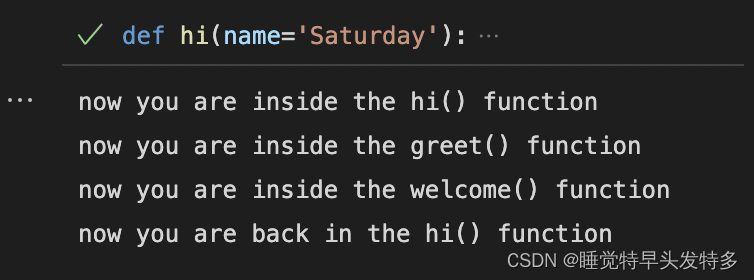24.一文理解Python函数装饰器
装饰器在 Python 使用如此方便都要归因于 Python 的函数能像普通的对象一样能作为参数传递给其他函数,可以被赋值给其他变量,可以作为返回值,可以被定义在另外一个函数内。
目录
0.前言
一、写出Python装饰器的步骤
1.一切皆对象
1.1Python中的函数
1.2函数赋值给变量
2.在函数中定义函数 创建嵌套函数
2.1注意🔗
3.从函数中返回函数
4.将函数作为参数传给另一个函数
4.1注意🔗:
5.第一个装饰器
5.1装饰器的一些常用场景
5.1.1蓝本规范
5.1.2注意🔗
5.2使用场景
5.2.1授权(Authorization)
5.3日志(Logging)
6.带参数的装饰器
6.1在函数中嵌入装饰器
6.2装饰器类
6.2.1添加email功能
@语法糖
@符号是装饰器的语法糖,它放在函数开始定义的地方,这样可以省略最后一步再次赋值的操作。
0.前言
装饰器(Decorators)是Python的一个重要部分;装饰器是修改其他函数的功能的函数,有助于让我们的代码更简洁。
一、写出Python装饰器的步骤
1.一切皆对象
1.1Python中的函数
def hi(name="passion"):
return "hi " + name
print(hi())
# output: hi passion
1.2函数赋值给变量
我们甚至可以将一个函数赋值给一个变量,如下所示:(我们没有使用小括号,因为我们并不是在调用hi函数,而是在将它放在greet变量里面。)
def hi(name="passion"):
return "hi " + name
print(hi())
# output: hi passion
greet = hi #没有使用小括号,是因为我们不是在调用hi()函数,而是将它赋值给变量greet!
print(greet())
#output =
# hi passion
# hi passion删掉旧的hi函数,看看运行结果:
def hi(name="passion"):
return "hi " + name
print(hi())
# output: hi passion
greet = hi
print(greet())
#output :
# hi passion
# hi passion
del hi
#print(hi())
#output:
# NameError : name 'hi' is not defined
print(greet())
#output:hi passion
# hi passion
# hi passion2.在函数中定义函数 创建嵌套函数
在Python中,我们可以在一个函数中定义另一个函数:
def hi(name='Saturday'): #定义hi() function
print("now you are inside the hi() function")
def greet():#在hi() function 中定义了 greet() function
return "now you are inside the greet() function"
def welcome():#在hi() function 中定义了 welcome() function
return "now you are inside the welcome() function"
print(greet())
print(welcome())
print("now you are back in the hi() function")
hi()2.1注意🔗
无论何时调用hi(),greet()和welcome()将会被同时调用,greet()和welcome()函数在hi()函数之外是不能访问的,如下所示:
def hi(name='Saturday'):
print("now you are inside the hi() function")
def greet():
return "now you are inside the greet() function"
def welcome():
return "now you are inside the welcome() function"
print(greet())
print(welcome())
print("now you are back in the hi() function")
#hi()
greet()NameError: name 'greet' is not defined
3.从函数中返回函数
其实并不需要在一个函数里去执行另一个函数,我们也可以将其作为输出返回出来:
def hi(name="enthusiasm"):
def greet():
return "now you are in the greet() function"
def welcome():
return "now you are in the welcome() function"
if name == "enthusiasm":
return greet
else:
return welcome
a = hi()
print(a)
output = <function hi.<locals>.greet at 0x106673700>
上面清晰地展示了"a"现在指向到hi()函数中的greet()函数 ,下面尝试print(a())
def hi(name="enthusiasm"):
def greet():
return "now you are in the greet() function"
def welcome():
return "now you are in the welcome() function"
if name == "enthusiasm":
return greet
else:
return welcome
a = hi()
print(a)
print(a())
output=
<function hi.<locals>.greet at 0x1043d3700>
now you are in the greet() function
再次看看这个代码,在if/else语句中我们返回greet和welcome,而不是greet()和welcome()。为什么呢?这是因为当我们把一对小括号放在后面,这个函数就会执行;然而在后面不放括号,它可以被到处传递,并且可以赋值给别的变量而不去执行它。
我们写下a = hi() ,hi()会被执行,而由于name参数默认是enthusiasm,所以函数greet被返回。如果我们语句改为a = hi(name = "happy"),那么welcome函数将被返回。我们还可以打印出hi()()即a(),输出"now you are in the greet() function"
4.将函数作为参数传给另一个函数
def hi():
return "hi goodbai"
def doSomethingBeforeHi(func):
print("I am doing some boring work before executing hi()")
print(func())
doSomethingBeforeHi(hi)

4.1注意🔗:
装饰器让你在一个函数前后去执行代。
5.第一个装饰器
在上一个例子里,我们已经创建了一个装饰器,现在我们修改下上一个装饰器,并编写一个具备更多功能的程序:
def a_new_decorator(a_func):
def wrapTheFunction():
print("I am doing some boring work before executing a_func()")
a_func()
print("I am doing some boring work after executing a_func()")
return wrapTheFunction
def a_function_requiring_decoration():
print("I am the function which needs some decoration to remove my foul sell")
a_function_requiring_decoration()

now, a_function_requiring_decoration is wrapped by wrapTheFunction()
def a_new_decorator(a_func):
def wrapTheFunction():
print("I am doing some boring work before executing a_func()")
a_func()
print("I am doing some boring work after executing a_func()")
return wrapTheFunction
def a_function_requiring_decoration():
print("I am the function which needs some decoration to remove my foul sell")
a_function_requiring_decoration()
a_function_requiring_decoration = a_new_decorator(a_function_requiring_decoration)
a_function_requiring_decoration()
我们刚刚应用到了之前学习到的原理。这正是python中装饰器做的事情!它们封装一个函数,并且用到这样或者那样的方式来修改他的行为。我们在代码里并没有使用@符号?那是一个简短的方式来生成一个被装饰的函数,我们使用@来运行之前的代码:
from re import A
def a_new_decorator(a_func):
def wrapTheFunction():
print("I am doing some boring work before executing a_func()")
a_func()
print("I am doing some boring work after executing a_func()")
return wrapTheFunction
def a_function_requiring_decoration():
print("I am the function which needs some decoration to remove my foul sell")
a_function_requiring_decoration()
a_function_requiring_decoration = a_new_decorator(a_function_requiring_decoration)
a_function_requiring_decoration()
@a_new_decorator
def a_function_requiring_decoration():
print("I am the function which needs some decoration to remove my foul smell")
a_function_requiring_decoration()

我们目前运行如下代码会存在一个问题:
print(a_function_requiring_decoration.__name__) # Output: wrapTheFunction
这并不是我们想要的输出结果,想要的输出结果应该是"a_function_requiring_decoration",这里的函数被wrapTheFunction替代了,它重写了我们函数的名字和注释文档(docstring)。幸运的是,Python提供给我们一个简单的函数来解决这个问题,那就是functools.wraps。我们修改上一个例子,来使用functools.wraps:
from functools import wraps
def a_new_decorator(a_func):
@wraps(a_func)
def wrapTheFunction():
print("I am doing some boring work before executing a_func()")
a_func()
print("I am doing some boring work after executing a_func()")
return wrapTheFunction
@a_new_decorator
def a_function_requiring_decoration():
print("I am the function which needs some decoration to remove my foul smell")
print(a_function_requiring_decoration.__name__)
5.1装饰器的一些常用场景
5.1.1蓝本规范
from functools import wraps
def decorator_name(f):
@wraps(f)
def decorated(*args, **kargs):
if not can_run:
return "Function will not run"
return f(*args, **kargs)
return decorated
@decorator_name
def func():
return("Function is running")
can_run = True
print(func())
# output: Function is running
can_run = False
print(func())
# output: Function wil not running
5.1.2注意🔗
@wraps接受一个函数来进行装饰,并加入了复制函数、注释文档、参数列表等等的功能,这可以让我们在装饰器里面访问在装饰之前的函数的属性。
5.2使用场景
让一些事情管理起来更简单。
5.2.1授权(Authorization)
装饰器能有助于检查某个人是否被授权去使用一个web应用的端点(endpoint),它们被大量使用于Flask和Django web框架中。这里是一个例子来使用基于装饰器的授权:
from functools import wraps
from requests import request
def requires_auth(f):
@wraps(f)
def decorated(*args, **kargs):
auth = request.authorization
if not auth or not check_auth(auth.username, auth.password):
authenticate()
return f(*args, **kargs)
return decorated

5.3日志(Logging)
日志是装饰器运用的另一个亮点。
from functools import wraps
def logit(func):
@wraps(func)
def with_logging(*args, **kargs):
print(func.__name__+" was called")
return func(*args, **kargs)
return with_logging
@logit
def addition_func(x):
return x + x
result = addition_func(4)
# output: addition_func was called6.带参数的装饰器
思考一个问题:@ wraps不也是个装饰器吗?它接受一个参数,就像任何普通的函数能做的那样。为什么我们不也那样做呢?因为,当我们使用@my_decorator语法时,你是在应用一个以单个函数作为参数的一个包裹函数。Python里每个东西都是一个对象,而且这包括函数!我们编写一个能返回一个包裹函数的函数。
6.1在函数中嵌入装饰器
我们回到日志的例子,并创建一个包裹函数,能让我们指定一个用于输出的日志文件。
from functools import wraps
def logit(logfile='out.log'):
def logging_decorator(func):
@wraps(func)
def wrapped_function(*args, **kwargs):
log_string = func.__name__ + " was called"
print(log_string)
# 打开logfile,并写入内容
with open(logfile, 'a') as opened_file:
# 现在将日志打到指定的logfile
opened_file.write(log_string + '\n')
return func(*args, **kwargs)
return wrapped_function
return logging_decorator
@logit()
def myfunc1():
pass
myfunc1()
# Output: myfunc1 was called
# 现在一个叫做 out.log 的文件出现了,里面的内容就是上面的字符串
@logit(logfile='func2.log')
def myfunc2():
pass
myfunc2()
# Output: myfunc2 was called
# 现在一个叫做 func2.log 的文件出现了,里面的内容就是上面的字符串6.2装饰器类
现在我们有了能用于正式环境的logit装饰器,但当我们的应用的某些部分还比较脆弱时,异常需要关注!
比方说有时只想打日志到一个文件。而有时想某个问题发送到一个email,同时也保留日志,留个记录。这是一个使用继承的场景,但目前为止我们只看到过用来构建装饰器的函数。幸运的是,类也可以用来构建装饰器。那我们现在以一个类而不是一个函数的方式,来重新构建logit。
from functools import wraps
class logit(object):
def __init__(self, logfile='out.log'):
self.logfile = logfile
def __call__(self, func):
@wraps(func)
def wrapped_function(*args, **kwargs):
log_string = func.__name__ + "was called"
print(log_string)
#打开logfile并写入
with open(self.logfile, 'a')as opened_file:
#现在将日志打到指定的文件
opened_file.write(log_string + '\n')
#现在,发送一个通知
self.notify()
return func(*args, **kwargs)
return wrapped_function
def notify(self):
# logit只打日志,不做别的
pass这个实现有一个附加优势,在于比嵌套函数的方式更加整洁,而且包裹一个函数还使用跟以前一样的语法:
@logit()
def myfunc1():
pass6.2.1添加email功能
我们现在给logit创建子类,来添加email的功能,一个logit的实现版本,可以在函数调用时发送email给管理员,还可以发送一封email到self.email.
from functools import wraps
class logit(object):
def __init__(self, logfile='out.log'):
self.logfile = logfile
def __call__(self, func):
@wraps(func)
def wrapped_function(*args, **kwargs):
log_string = func.__name__ + "was called"
print(log_string)
#打开logfile并写入
with open(self.logfile, 'a')as opened_file:
#现在将日志打到指定的文件
opened_file.write(log_string + '\n')
#现在,发送一个通知
self.notify()
return func(*args, **kwargs)
return wrapped_function
def notify(self):
# logit只打日志,不做别的
pass
#一个logit的实现版本,可以在函数调用时发送email给管理员
class email_logit(logit):
def __init__(self, email='admin@my project.com', *args, **kwargs):
self.email = email
super(email_logit, self).__init__(*args, **kwargs)
@email_logit 将会和 @logit 产生同样的效果,但是在打日志的基础上,还会多发送一封邮件给管理员。


